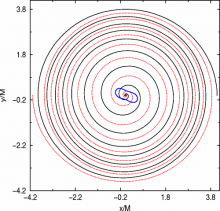
Abstract
We evolve equal-mass, equal-spin black-hole binaries with specific spins of a/mH 0.925, the highest spins simulated thus far and nearly the largest possible for Bowen-York black holes, in a set of configurations with the spins counter-aligned and pointing in the orbital plane, which maximizes the recoil velocities of the merger remnant, as well as a configuration where the two spins point in the same direction as the orbital angular momentum, which maximizes the orbital hang-up effect and remnant spin. The coordinate radii of the individual apparent horizons in these cases are very small and the simulations require very high central resolutions (h~M/320). We find that these highly spinning holes reach a maximum recoil velocity of ~3300 km/s (the largest simulated so far) and, for the hangup configuration, a remnant spin of a/mH 0.922. These results are consistent with our previous predictions for the maximum recoil velocity of ~4000 km/s and remnant spin; the latter reinforcing the prediction that cosmic censorship is not violated by merging highly-spinning black-hole binaries. We also numerically solve the initial data for, and evolve, a single maximal-Bowen-York-spin black hole, and confirm that the 3-metric has an O(1/r^2) singularity at the puncture, rather than the usual O(1/r^4) singularity seen for non-maximal spins.